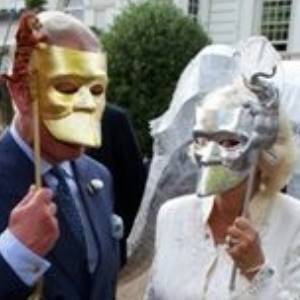
PIERROT OR PEDROLINO – THE SAD CLOWN FROM COMMEDIA DELL’ARTE
August 1, 2022
Colombina – Venetian Theatre Character
August 1, 2022WHO IS HARLEQUIN FROM COMMEDIA DELLE’ARTE
Harlequin, in Italian: Arlecchino, is one of the key players in the masked theatre of the Italian Commedia dell’arte and also one of the most popular. In addition to his role as a comic servant to Pantalone, Il Capitano, and Il Dottore, he is an amorous acrobat, in love with Colombina while being an inveterate womanizer.
HOW DOES HARLEQUIN IDENTITY AND WHAT IS HIS APPEARANCE?
In the early days of the Commedia (mid-16th century), Arlecchino was portrayed as slow-witted and poor, forever hungry and desperate for money. Despite these difficulties, he showed no desire to work but instead set about hoodwinking everyone with his unscrupulous behaviour.
By the early 17th century, he had become guileful, brazen and always in high spirits. A master of disguises, he assumes a variety of professional mantles to misrepresent his status, often masquerading as a foreign nobleman.
No longer the pathetic clown, Arlecchino has become increasingly shrewd, able to thwart the plans of his master (his competitor) in his pursuit of Colombina. He manages to extricate himself from problematic affairs with growing wit and resourcefulness, occasionally pursuing the innamorata, though with little success. Nevertheless, Harlequin is now seen as a romantic hero rather than a blundering halfwit.
Originally talking in a parrot-like Bergamasque dialect, Harlequin now speaks a mixture of French and Italian. On stage he uses agile acrobatic skills and performs magical tricks, transforming objects around him with his baton. While invariably living up to his reputation as a mischievous “devil”, with trickster qualities, he bears no ill will towards those who treat him in a beastly fashion.
Over time, Harlequin’s costume has undergone a series of changes. Originally, in the mid-16th century, his clothes hung loosely and were sewn with patches. His outfit consisted of a mask, black belt, collar ruffles, and a narrow hat with an upturned brim (decorated with the tail of a rabbit, hare or fox, or sometimes with a tuft of feathers).
However, in the 17th century, his attire developed into his signature tight-fitting costume comprising irregular blue, red and green triangles and diamond lozenges in a symmetrical pattern. A double pointed hat took the place of the original one and his ‘slapstick’ or ‘battocchio’ hung from his belt.
WHAT IS THE ORIGIN OF HIS CHARACTER?
In the Middle Ages, there were many carnival characters cast as devilish fools and known as Herliquins or Hellequins and, in France and Italy in particular, they played an important theatrical role.
The first known appearance on stage of the Hellequin dates back to 1262, with the character of a masked and hooded devil in “Jeu da la Feuillière” by Adam de la Halle. The play is a satirical fantasy based on his own life and the Hellequin became a stock character in French passion plays.
However, Zan Ganassa, an early Italian actor from Bergamo, is conventionally believed to have introduced Arlecchino in the late 16th century. The Italian actor Tristano Martinelli of Mantua, a member of the Raccolti troupe, popularised the character in Paris during 1584–1585. Arlecchino appears in his 1601 publication “Compositions de Rhetorique” and Martinelli himself played the Harlequin for several famous companies.
The character also appeared in a document published in the “Prologue to Fiammella” by the comic writer Bartolomeo Rossi, where “Arlequin” was mentioned together with “Pedrolino” (the future Pierrot). Nevertheless, it was only after Martinelli’s death in 1630 that Arlecchino became a recognised stock character and built himself a history.
Among the earliest depictions of Arlecchino are a Flemish painting (1571-1572) exhibited in the Museum of Bayeux in Normandy, and several woodblock prints probably dating from the 1580s in the Fossard collection.
WHAT MASK DID HARLEQUIN WEAR?
Harlequin’s mask originally bore a strong resemblance to that of omo salvadego (“The Savage Man”), a simple primitive disguise made from wood.
It was later replaced by a more sophisticated and less savage domino mask, signifying the changes in Harlequin’s stage persona. This was a black half-mask typical of the late Harlequin’s representations on stage. Constructed from leather, it combined the features of a feline and a devil.
Harlequin’s mask is easily recognizable even today due to its prominent chin-piece, carbuncles on the brow, and tiny slits for the eyes. The mask’s forehead is heavily lined with wrinkles, giving a slightly quizzical arch to the eyebrows.
WHAT CHARACTER DID HE PLAY AND WHAT IS HIS PERSONALITY?
Prior to the 17th century, Arlecchino was portrayed as an incompetent zanni servant from northern Italy, clownish and absent-minded. His clumsiness and ignorance, however, often held a wayward charm that made his antics all the more amusing.
Despite constant obstacles, he survived through a mix of wit and deceitfulness. Some even compared him with a chameleon as he was very likely to be in disguise, all the better to create more impetuous devilment. Later he becomes more quick-witted.
A primary aspect of Arlecchino is his physical agility. He jumps, dances and turns somersaults. Harlequin encourages the audience to laugh whilst empathising with his character, but he takes little or no part in the development of the plot. His role is to maintain the even rhythm of the comedy as a whole.
HOW DID HE ACT?
Arlecchino’s movements are stylistic variations of ballet, including a three-time walk with little tiptoe steps which he shows off to Colombina. Depending on who he’s talking to, he may dance clumsily or slowly, sometimes appearing humpbacked.
He likes to stick his head through people’s legs or arms, or over their shoulder, and use props in an unexpected manner. He may make asides to the spectators before returning to complete absorption in the action on stage.
SUMMARY OF HARLEQUIN THE COMMEDIA DELL’ARTE CHARACTER
From the impoverished fool of the 16th century to the sharp operator of later centuries, Arlecchino is an enduring and endearing character who personifies many fundamental human characteristics.
While the iconic image of Harlequin may be best remembered from Maurice Sand’s 19th century depiction, part of his monumental study of “Commedia dell’arte: masques et bouffons” (1860), Harlequin is abundantly represented in art.
Following regular appearances in the puppet theatres of the 19th century, Arlecchino has been a great source of inspiration for many important artists such as Paul Cézanne and Pablo Picasso.



